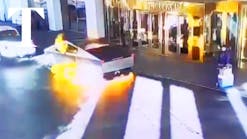Getting to Know Each Other Prepares Wash. Neighborhood
Source The Columbian, Vancouver, Wash.
June 26--Residents of the Fairway Village neighborhood are preparing for emergencies the old-fashioned way -- by getting to know their neighbors.
The east Vancouver community uses a state-backed program called Map Your Neighborhood to create block-by-block disaster plans in the event the "Big One" hits. Through the program, people map out emergency routes and identify the skills, equipment and special needs everyone in their neighborhood has. The program, its supporters say, is akin to data mining a neighborhood for bits of information about everyone who lives there.
With images still surfacing of the destruction leveled last month by two Oklahoma tornadoes, coupled with fears in the Pacific Northwest of a Cascadia subduction zone earthquake striking sometime in the future, residents say they want to give themselves the tools to thrive during worst-case scenarios.
Chief among those tools: simply knowing each other.
"We're living in a 55-and-older community," said Vikki Hamilton, Fairway Village's Neighborhood Watch coordinator, "so we want to know if people have medical issues or need extra help."
She said the program ensures lines of communication stay open even during times of duress. Thanks to a handful of "block leaders" and Neighborhood Watch volunteers -- who act as evangelists for the program, visiting neighbors and selling them on it -- Map Your Neighborhood has gained a following in the tightly-knit community.
The program was started by the Washington Military Department Emergency Management Division about seven years ago. Through local emergency management offices, residents receive training on what to do following a calamity.
Cindy Stanley, an emergency management coordinator for Clark Regional Emergency Services Agency, said it's essential for neighbors to watch out for each other.
But while studies show that people who know their neighbors tend to look out for each other, there's evidence that people now have less contact with their neighbors than in the past.
According to a 2010 Pew Research center survey, only four in 10 Americans say they know all or even most of their neighbors.
Map Your Neighborhood, Stanley said, is geared primarily toward earthquake safety, but it could be used for any type of cataclysmic event. Fairway Village isn't the only neighborhood to use the program. Elsewhere in Clark County, Stanley added, neighborhoods have bought into the program.
"It's impossible for us to assume that help will come to us directly," she said, "so it's important for us to be as prepared as possible."
Stanley said summer was the perfect time for neighbors to get a program going because people are already outside. The optimum number of houses that can be involved in a program is between 10 and 20, she said, but that number can increase if the program is broken up into manageable chunks.
Cathy Starr, Fairway Village's former Neighborhood Watch coordinator, was responsible for implementing the program when she moved to the enclave in 2007.
Executing the program was a massive responsibility, Starr said, taking her about a year to complete. It brought her into contact with nearly all of the neighborhood's 1,200 residents.
The program will need to be updated in the near future, she said. In the last couple of years, about 100 people have moved into the neighborhood, meaning there are new faces and information to compile.
Neighborly awareness
Rifling through a booklet of neighborhood information -- with maps of each block featuring people's names, phone numbers and email addresses -- Hamilton and fellow Neighborhood Watch coordinator Barbara Gassin pointed out all of the data they've compiled for Fairway Village.
Next to people's names, there are scribbles of corresponding information, detailing any special equipment, training or needs they have.
Most people don't have a problem providing personal details, Hamilton said, but some people opt out of participating. Every new resident receives a card, on which they can list whether they suffer from major maladies or are allergic to any medicines.
Although Fairway Village has been free of earthquakes and other large-scale natural disasters, the information culled from the Map Your Neighborhood program has been used during storms.
Gassin and Hamilton point to the so-called "Arctic Blast" of 2008, when streets became impassable because of snow and ice.
During the storm, one elderly woman in Fairway Village went three days without receiving a visit from a home care nurse, who couldn't navigate the snowy roads. Neighbors helped out in the nurse's absence.
Gassin, a Bay Area transplant who moved to Washington in 2005, found herself off guard when she realized she didn't own any snow chains for her car.
A neighbor came to the rescue and transported Gassin to the grocery store so she could go shopping.
"It's that kind of neighborhood, where anyone will do something for you," she said.
Looking back on how Map Your Neighborhood had taken shape, Starr said the program has empowered the neighborhood.
After all, there's nothing stronger than neighbors staying vigilant together.
"If nothing else, people have become acquainted with their neighbors," she said. "And I think people were pleased to get out and take a stand against the unknown."
Tyler Graf: 360-735-4517; http://twitter.com/col_smallcities; [email protected]
Copyright 2013 - The Columbian, Vancouver, Wash.





